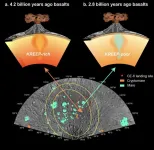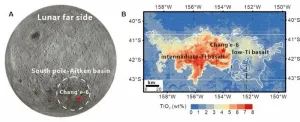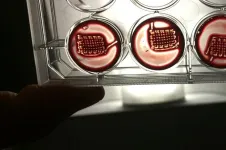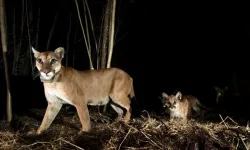(Press-News.org) A new route to materials with complex ‘disordered’ magnetic properties at the quantum level has been produced by scientists for the first time.
The material, based on a framework of ruthenium, fulfils the requirements of the ‘Kitaev quantum spin liquid state’ - an elusive phenomenon that scientists have been trying to understand for decades.
Published in Nature Communications the study, by scientists at the University of Birmingham, offers an important step towards achieving and controlling quantum materials with sought-after new properties that do not follow classical laws of physics.
Crucially, the materials provide a route to magnetic properties which behave differently from conventional ‘ferromagnets’, ordered around two poles. Ferromagnets – which include the familiar bar magnets found on fridges or noticeboards – contain electrons which interact with each other, each functioning as a tiny magnet to attract and repel, so that they all point in the same direction, giving the magnet its force.
Quantum spin liquid materials have magnetic properties that don’t behave in that way. Instead of the well-ordered characteristics of ferromagnets, these materials are disordered and the electrons within them connect magnetically via a process called quantum entanglement.
Although quantum spin liquids exist in theory and have been modelled by scientists, it has not previously been possible to produce them experimentally or to find them in nature.
In the new study, researchers describe the properties of a novel ruthenium-based material that opens up new pathways for exploring these states of matter.
Lead researcher Dr Lucy Clark explains: “This work is a really important step in understanding how we can engineer new materials that allow us to explore quantum states of matter. It opens up a large family of materials that have so far been underexplored and which could yield important clues about how we can engineer new magnetic properties for use in quantum applications.”
While there are a number of naturally occurring copper minerals and mineral crystal systems in which scientists believe quantum spin liquid state might exist, these have not been proved due to the additional structural complexities found in nature. The complexity of quantum spin liquids poses difficulties for theorists too, because modelling results in many competing magnetic interactions, which are extremely difficult to untangle, causing disagreement among physicists.
A model produced by the theoretical physicist Alexei Kitaev in 2009 was able to demonstrate some foundational principles for quantum spin liquids, however the magnetic interactions it described required an environment that scientists have been unable to produce experimentally without the materials reverting to a conventionally ordered magnetic state.
It is thought this behaviour is connected to the densely packed crystal structures of candidate materials. Because the ions are packed so closely together they are able to interact directly with each other, resulting in them reverting to magnetic order.
Using specialist instruments at the UK’s ISIS Neutron and Muon Source, and Diamond Light Source, the Birmingham-based team were able to show that a new material with an open framework structure can tune the interactions between the ruthenium metal ions, providing a new route the Kitaev quantum spin liquid state.
Importantly, the magnetic interactions produced within these more open structures are weaker than they might otherwise be, giving scientists more scope to tune their precise behaviours.
“While this work has not led to a perfect Kitaev material, it has demonstrated a useful bridge between theory in this field and experimentation, and opened up fruitful new areas for research,” added Dr Clark.
END
New route to ‘quantum spin liquid’ materials discovered for first time
2024-11-15
ELSE PRESS RELEASES FROM THIS DATE:
Chang’e-6 basalts offer insights on lunar farside volcanism
2024-11-15
Basalt samples returned by the Chang’e-6 mission have revealed volcanic events on the lunar farside at 2.8 billion years ago (Ga) and 4.2 Ga, according to research conducted by Prof. LI Qiuli’s lab at the Institute of Geology and Geophysics of the Chinese Academy of Sciences. This work was recently published in Nature.
“Unraveling the volcanic history of the lunar farside is crucial for understanding the hemispheric dichotomy of the Moon,” said Prof. LI.
The asymmetry between the Moon’s nearside and farside—encompassing differences in basalt distribution, topography, crustal thickness, and thorium ...
Chang’e-6 lunar samples reveal 2.83-billion-year-old basalt with depleted mantle source
2024-11-15
The Moon has a global dichotomy, with its near and far sides having different geomorphology, topography, chemical composition, crustal thickness, and evidence of volcanism.
To better understand this dichotomy, Professor XU Yigang’s team from the Guangzhou Institute of Geochemistry of the Chinese Academy of Sciences investigated lunar soil samples from the far side South Pole-Aitken (SPA) Basin of the Moon returned by the Chang’e-6 mission.
Their work was published in Science on Nov. 15.
“The samples returned by Chang’e-6 provide a best opportunity to investigate the lunar global dichotomy,” said Professor ...
Zinc deficiency promotes Acinetobacter lung infection: study
2024-11-15
Dietary zinc deficiency promotes lung infection by Acinetobacter baumannii bacteria — a leading cause of ventilator-associated pneumonia, according to a new study published Nov. 15 in the journal Nature Microbiology.
A Vanderbilt University Medical Center-led team of researchers discovered an unexpected link between the pro-inflammatory cytokine interleukin-13 (IL-13) and A. baumannii lung infection, and they demonstrated that blocking IL-13 prevented infection-associated death in an animal model.
The findings suggest that anti-IL-13 antibodies, which are FDA-approved for use in humans, may protect against bacterial pneumonia in patients with zinc deficiency.
“To ...
How optogenetics can put the brakes on epilepsy seizures
2024-11-15
In what could one day become a new treatment for epilepsy, researchers at UC San Francisco, UC Santa Cruz and UC Berkeley have used pulses of light to prevent seizure-like activity in neurons.
The researchers used brain tissue that had been removed from epilepsy patients as part of their treatment.
Eventually, they hope the technique will replace surgery to remove the brain tissue where seizures originate, providing a less invasive option for patients whose symptoms cannot be controlled with medication.
The ...
Children exposed to antiseizure meds during pregnancy face neurodevelopmental risks, Drexel study finds
2024-11-15
Children born to mothers who take antiseizure medications to manage seizures and psychiatric conditions during pregnancy may face increased risks of neurodevelopmental conditions, according to new data from researchers at Drexel’s Dornsife School of Public Health.
The current work -- using data from more than three million children from the United Kingdom and Sweden, including 17,495 who were exposed to antiseizure medications during pregnancy -- found that children exposed to the antiseizure drug lamotrigine ...
Adding immunotherapy to neoadjuvant chemoradiation may improve outcomes in esophageal cancer
2024-11-15
Bottom Line: In patients with unresectable, locally advanced esophageal cancer, the triple combination of radiation, chemotherapy, and immunotherapy made tumors more amenable to surgery, which was associated with significantly improved outcomes.
Journal in Which the Study was Published: Clinical Cancer Research, a journal of the American Association for Cancer Research.
Background: “Curative resection unequivocally serves as the cornerstone for treating resectable esophageal squamous cell carcinoma (ESCC); ...
Scientists transform blood into regenerative materials, paving the way for personalized, blood-based, 3D-printed implants
2024-11-15
Scientists have created a new ‘biocooperative’ material based on blood, which has shown to successfully repair bones, paving the way for personalised regenerative blood products that could be used as effective therapies to treat injury and disease.
Researchers from the Schools of Pharmacy and Chemical Engineering at the University of Nottingham have used peptide molecules that can guide key processes taking place during the natural healing of tissues to create living materials that enhance tissue regeneration. The research published today in Advanced ...
Maarja Öpik to take up the position of New Phytologist Editor-in-Chief from January 2025
2024-11-15
The New Phytologist Foundation is delighted to announce that Professor Maarja Öpik will take up the position of Editor-in-Chief of New Phytologist from January 2025 for an initial term of five years.
Maarja has served as a member of New Phytologist's editorial board since 2013 and is Professor of Molecular Ecology and Director of the Institute of Ecology and Earth Sciences at the Faculty of Science and Technology at the University of Tartu, Estonia.
Maarja’s research addresses the interactions between plants and mycorrhizal fungi, with ...
Mountain lions coexist with outdoor recreationists by taking the night shift
2024-11-15
Mountain lions in greater Los Angeles are proactively shifting their activity to avoid interacting with cyclists, hikers, joggers and other recreationists, finds a study from the University of California, Davis, Cal Poly Pomona and the National Park Service.
The study, published Nov. 15 in the journal Biological Conservation, found that mountain lions living in areas with higher levels of human recreation were more nocturnal than lions in more remote regions who were more active at dawn and dusk. The authors said their findings offer a hopeful example of human-wildlife coexistence amid a large, dense human population.
“People are increasingly enjoying recreating ...
Students who use dating apps take more risks with their sexual health
2024-11-15
In May, the WHO raised the alarm over the rise in incidence of sexually transmitted illnesses (STIs) in many regions of the world, currently running at more than a million new cases per day. Among high-income countries, the US has one of the highest prevalences of STIs, and this problem is getting worse. For example, the incidence of chlamydia has more than doubled since 2000, while gonorrhea increased by 40% and syphilis by 400%. The highest prevalence is among young adults between 20 and 34 years of age.
Over ...




